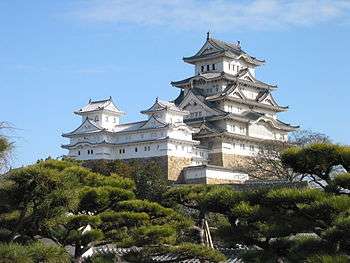Plaster


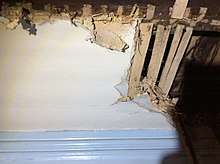
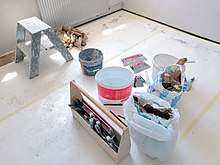
Plaster is a building material used for the protective or decorative coating of walls and ceilings and for moulding and casting decorative elements.[1] In English "plaster" usually means a material used for the interiors of buildings, while "render" commonly refers to external applications.[2] Another imprecise term used for the material is stucco, which is also often used for plasterwork that is worked in some way to produce relief decoration, rather than flat surfaces.
The most common types of plaster mainly contain either gypsum, lime, or cement,[3] but all work in a similar way. The plaster is manufactured as a dry powder and is mixed with water to form a stiff but workable paste immediately before it is applied to the surface. The reaction with water liberates heat through crystallization and the hydrated plaster then hardens.
Plaster can be relatively easily worked with metal tools or even sandpaper, and can be moulded, either on site or to make pre-formed sections in advance, which are put in place with adhesive. Plaster is not a strong material; it is suitable for finishing, rather than load-bearing, and when thickly applied for decoration may require a hidden supporting framework, usually in metal.
Forms of plaster have several other uses. In medicine plaster orthopedic casts are still often used for supporting set broken bones. In dentistry plaster is used to make dental models. Various types of models and moulds are made with plaster. In art, lime plaster is the traditional matrix for fresco painting; the pigments are applied to a thin wet top layer of plaster and fuse with it so that the painting is actually in coloured plaster. In the ancient world, as well as the sort of ornamental designs in plaster relief that are still used, plaster was also widely used to create large figurative reliefs for walls, though few of these have survived.
Types
Clay plaster
Clay plaster is a mixture of clay, sand and water with the addition of plant fibers for tensile strength over wood lath.
Clay plaster has been used since antiquity. Settlers in the American colonies used clay plaster on the interiors of their houses: “Interior plastering in the form of clay antedated even the building of houses of frame, and must have been visible in the inside of wattle filling in those earliest frame houses in which …wainscot had not been indulged. Clay continued in the use long after the adoption of laths and brick filling for the frame."[4] Where lime was not available or easily accessible it was rationed or substituted with other binders. In Martin E. Weaver’s seminal work he says, “Mud plaster consists of clay or earth which is mixed with water to give a “plastic” or workable consistency. If the clay mixture is too plastic it will shrink, crack and distort on drying. It will also probably drop off the wall. Sand and fine gravels were added to reduce the concentrations of fine clay particles which were the cause of the excessive shrinkage.”[5] Straw or grass was added sometimes with the addition of manure.
In the Earliest European settlers’ plasterwork, a mud plaster was used or more usually a mud-lime mixture.[6] In Harley McKee’s book on early American masonry[4] he writes, of a circa 1675 Massachusetts contract that specified the plasterer, “Is to lath and siele[7] the four rooms of the house betwixt the joists overhead with a coat of lime and haire upon the clay; also to fill the gable ends of the house with ricks and plaister them with clay. 5. To lath and plaster partitions of the house with clay and lime, and to fill, lath, and plaister them with lime and haire besides; and to siele and lath them overhead with lime; also to fill, lath, and plaster the kitchen up to the wall plate on every side. 6. The said Daniel Andrews is to find lime, bricks, clay, stone, haire, together with laborers and workmen… .”[8] Records of the New Haven colony in 1641 mention clay and hay as well as lime and hair also. In German houses of Pennsylvania the use of clay persisted.”[9]
Old Economy Village is one such German settlement. The early Nineteenth-Century utopian village in present-day Ambridge, Pennsylvania, used clay plaster substrate exclusively in the brick and wood frame high architecture of the Feast Hall, Great House and other large and commercial structures as well as in the brick, frame and log dwellings of the society members. The use of clay in plaster and in laying brickwork appears to have been a common practice at that time not just in the construction of Economy village when the settlement was founded in 1824. Specifications for the construction of, “Lock keepers houses on the Chesapeake and Ohio Canal, written about 1828, require stone walls to be laid with clay mortar, excepting 3 inches on the outside of the walls…which (are) to be good lime mortar and well pointed.”[10] The choice of clay was because of its low cost, but also the availability. At Economy, root cellars dug under the houses yielded clay and sand (stone), or the nearby Ohio river yielded washed sand from the sand bars; and lime outcroppings and oyster shell for the lime kiln. Other required building materials were also sourced locally.
The surrounding forests of the new village of Economy provided straight grain, old-growth oak trees for lath.[11] Hand split lath starts with a log of straight grained wood of the required length. The log is spit into quarters and then smaller and smaller bolts with wedges and a sledge. When small enough, a froe and mallet were used to split away narrow strips of lath - unattainable with field trees and their many limbs. Farm animals pastured in the fields cleared of trees provided the hair and manure for the float coat of plaster. Fields of wheat and grains provided straw and other grasses for binders for the clay plaster. But there was no uniformity in clay plaster recipes.
Straw or grass was added sometimes with the addition of manure providing fiber for tensile strength as well as protein adhesive. Proteins in the manure act as binders. The hydrogen bonds of proteins must stay dry to remain strong, so the mud plaster must be kept dry.[12] With braced timber framed structures clay plaster was used on interior walls and ceilings as well as exterior walls as the wall cavity and exterior cladding isolated the clay plaster from moisture penetration. Application of clay plaster in brick structures risked water penetration from failed mortar joints on the exterior brick walls. In Economy Village, the rear and middle wythes of brick dwelling walls are laid in a clay and sand mortar with the front wythe bedded in a lime and sand mortar to provide a weather proof seal to protect from water penetration. This allowed a rendering of clay plaster and setting coat of thin lime and fine sand on exterior-walled rooms.
Split lath was nailed with square cut lath nails, one into each framing member. With hand split lath the plasterer had the luxury of making lath to fit the cavity being plastered. Lengths of lath two to six foot are not uncommon at Economy Village. Hand split lath is not uniform like sawn lath. The straightness or waviness of the grain affected the thickness or width of each lath, and thus the spacing of the lath. The clay plaster rough coat varied to cover the irregular lath. Window and door trim as well as the mudboard (baseboard) acted as screeds. With the variation of the lath thickness and use of coarse straw and manure, the clay coat of plaster was thick in comparison to later lime-only and gypsum plasters. In Economy Village, the lime top coats are thin veneers often an eighth inch or less attesting to the scarcity of limestone supplies there.
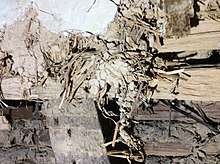
Clay plasters with their lack of tensile and compressive strength fell out of favor as industrial mining and technology advances in kiln production led to the exclusive use of lime and then gypsum in plaster applications. However, clay plasters still exist after hundreds of years clinging to split lath on rusty square nails. The wall variations and roughness reveal a hand-made and pleasing textured alternative to machine-made modern substrate finishes. But clay plaster finishes are rare and fleeting. According to Martin Weaver, “Many of North America’s historic building interiors…are all too often…one of the first things to disappear in the frenzy of demolition of interiors which has unfortunately come to be a common companion to “heritage preservation” in the guise of building rehabilitation.”[13]
Gypsum plaster
Gypsum plaster, or plaster of Paris, is produced by heating gypsum to about 300 °F (150 °C):[14]
- CaSO4·2H2O + heat → CaSO4·0.5H2O + 1.5H2O (released as steam).
When the dry plaster powder is mixed with water, it re-forms into gypsum. The setting of unmodified plaster starts about 10 minutes after mixing and is complete in about 45 minutes; but not fully set for 72 hours.[15] If plaster or gypsum is heated above 266 °F (130 °C), hemihydrate is formed, which will also re-form as gypsum if mixed with water.[16][17]
On heating to 180 °C, the nearly water-free form, called γ-anhydrite (CaSO4·nH2O where n = 0 to 0.05) is produced. γ-Anhydrite reacts slowly with water to return to the dihydrate state, a property exploited in some commercial desiccants. On heating above 250 °C, the completely anhydrous form called β-anhydrite or dead burned plaster is formed.
A large gypsum deposit at Montmartre in Paris led "calcined gypsum" (roasted gypsum or gypsum plaster) to be commonly known as "plaster of Paris".[18]
Plasterers often use gypsum to simulate the appearance of surfaces of wood, stone, or metal, on movie and theatrical sets for example. Nowadays, theatrical plasterers often use expanded polystyrene, although the job title remains unchanged.
Plaster of Paris can be used to impregnate gauze bandages to make a sculpting material called plaster bandages. It is used similarly to clay, as it is easily shaped when wet, yet sets into a resilient and lightweight structure. This is the material that was (and sometimes still is) used to make classic plaster orthopedic casts to protect limbs with broken bones, the artistic use having been partly inspired by the medical use (see orthopedic cast). Set Modroc is an early example of a composite material. The hydration of plaster of Paris relies on the reaction of water with the dehydrated or partially hydrated calcium sulfate present in the plaster.
Lime plaster
Lime plaster is a mixture of calcium hydroxide and sand (or other inert fillers). Carbon dioxide in the atmosphere causes the plaster to set by transforming the calcium hydroxide into calcium carbonate (limestone). Whitewash is based on the same chemistry.
To make lime plaster, limestone (calcium carbonate) is heated above approximately 850 °C to produce quicklime (calcium oxide). Water is then added to produce slaked lime (calcium hydroxide), which is sold as a wet putty or a white powder. Additional water is added to form a paste prior to use. The paste may be stored in airtight containers. When exposed to the atmosphere, the calcium hydroxide very slowly turns back into calcium carbonate through reaction with atmospheric carbon dioxide, causing the plaster to increase in strength.
Lime plaster was a common building material for wall surfaces in a process known as lath and plaster, whereby a series of wooden strips on a studwork frame was covered with a semi-dry plaster that hardened into a surface. The plaster used in most lath and plaster construction was mainly lime plaster, with a cure time of about a month. To stabilize the lime plaster during curing, small amounts of plaster of Paris were incorporated into the mix. Because plaster of Paris sets quickly, "retardants" were used to slow setting time enough to allow workers to mix large working quantities of lime putty plaster. A modern form of this method uses expanded metal mesh over wood or metal structures, which allows a great freedom of design as it is adaptable to both simple and compound curves. Today this building method has been partly replaced with drywall, also composed mostly of gypsum plaster. In both these methods, a primary advantage of the material is that it is resistant to a fire within a room and so can assist in reducing or eliminating structural damage or destruction provided the fire is promptly extinguished.
Lime plaster is used for frescoes, where pigments, diluted in water, are applied to the still wet plaster.
USA and Iran are the main plaster producers in the world.
Cement plaster
Cement plaster is a mixture of suitable plaster, sand, portland cement and water which is normally applied to masonry interiors and exteriors to achieve a smooth surface. Interior surfaces sometimes receive a final layer of gypsum plaster. Walls constructed with stock bricks are normally plastered while face brick walls are not plastered. Various cement-based plasters are also used as proprietary spray fireproofing products. These usually use vermiculite as lightweight aggregate. Heavy versions of such plasters are also in use for exterior fireproofing, to protect LPG vessels, pipe bridges and vessel skirts.
Cement plaster was first introduced in America around 1909 and was often called by the generic name adamant plaster after a prominent manufacturer of the time. The advantages of cement plaster noted at that time were its strength, hardness, quick setting time and durability.[19]
Heat resistant plaster
Heat resistant plaster is a building material used for coating walls and chimney breasts. Its purpose is to replace conventional gypsum plasters in cases where the temperature can get too high for gypsum plaster to stay on the wall. Heat resistant plaster should be used in cases where the wall is likely to exceed temperatures of 50 °C.
Uses
Architecture

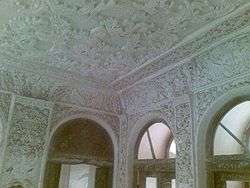
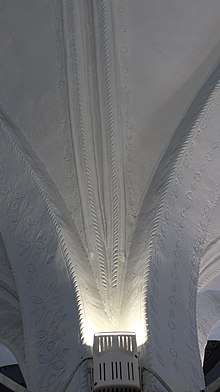
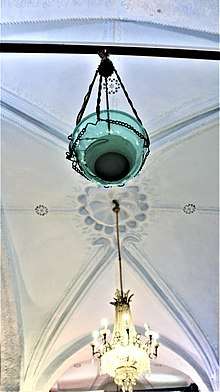
Plaster may also be used to create complex detailing for use in room interiors. These may be geometric (simulating wood or stone) or naturalistic (simulating leaves, vines, and flowers). These are also often used to simulate wood or stone detailing found in more substantial buildings.
In modern days this material is also used for False Ceiling. In this, the powder form is converted in a sheet form and the sheet is then attached to the basic ceiling with the help of fasteners. It is done in various designs containing various combinations of lights and colors. The common use of this plaster can be seen in the construction of houses. After the construction, direct painting is possible (the French do it), but elsewhere plaster is used. The walls are painted with the plaster which (in some countries) is nothing but calcium carbonate. After drying the calcium carbonate plaster turns white and then the wall is ready to be painted. Elsewhere in the world, such as the UK, ever finer layers of plaster are added on top of the plasterboard (or sometimes the brick wall directly) to give a smooth brown polished texture ready for painting.
Art
Many of the greatest mural paintings in Europe, like Michelangelo's Sistine Chapel ceiling, are executed in fresco, meaning they are painted on a thin layer of wet plaster, called intonaco; the pigments sink into this layer so that the plaster itself becomes the medium holding them, which accounts for the excellent durability of fresco. Additional work may be added a secco on top of the dry plaster, though this is generally less durable.
Plaster (often called stucco in this context) is a far easier material for making reliefs than stone or wood, and was widely used for large interior wall-reliefs in Egypt and the Near East from antiquity into Islamic times (latterly for architectural decoration, as at the Alhambra), Rome, and Europe from at least the Renaissance, as well as probably elsewhere. However, it needs very good conditions to survive long in unmaintained buildings – Roman decorative plasterwork is mainly known from Pompeii and other sites buried by ash from Mount Vesuvius.
Plaster may be cast directly into a damp clay mold. In creating this piece molds (molds designed for making multiple copies) or waste molds (for single use) would be made of plaster. This "negative" image, if properly designed, may be used to produce clay productions, which when fired in a kiln become terra cotta building decorations, or these may be used to create cast concrete sculptures. If a plaster positive was desired this would be constructed or cast to form a durable image artwork. As a model for stonecutters this would be sufficient. If intended for producing a bronze casting the plaster positive could be further worked to produce smooth surfaces. An advantage of this plaster image is that it is relatively cheap; should a patron approve of the durable image and be willing to bear further expense, subsequent molds could be made for the creation of a wax image to be used in lost wax casting, a far more expensive process. In lieu of producing a bronze image suitable for outdoor use the plaster image may be painted to resemble a metal image; such sculptures are suitable only for presentation in a weather-protected environment.
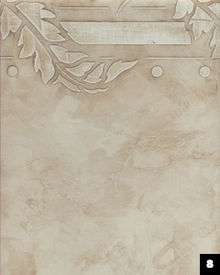
Plaster expands while hardening then contracts slightly just before hardening completely. This makes plaster excellent for use in molds, and it is often used as an artistic material for casting. Plaster is also commonly spread over an armature (form), made of wire mesh, cloth, or other materials; a process for adding raised details. For these processes, limestone or acrylic based plaster may be employed, known as stucco.
Products composed mainly of plaster of Paris and a small amount of Portland cement are used for casting sculptures and other art objects as well as molds. Considerably harder and stronger than straight plaster of Paris, these products are for indoor use only as they rapidly degrade in the rain.
Funeral processes
Plaster is used by many morticians and funeral home directors to recreate destroyed tissue, reconnect severed limbs to corpses, and to fill wounds sustained during the accident or murder that caused the death.
Medicine
Plaster is widely used as a support for broken bones; a bandage impregnated with plaster is moistened and then wrapped around the damaged limb, setting into a close-fitting yet easily removed tube, known as an orthopedic cast.
Plaster is also used in preparation for radiotherapy when fabricating individualized immobilization shells for patients. Plaster bandages are used to construct an impression of a patient's head and neck, and liquid plaster is used to fill the impression and produce a plaster bust. The transparent material polymethyl methacrylate (Plexiglas, Perspex) is then vacuum formed over this bust to create a clear face mask which will hold the patient's head steady while radiation is being delivered.
In dentistry, plaster is used for mounting casts or models of oral tissues. These diagnostic and working models are usually made from dental stone, a stronger, harder and denser derivative of plaster which is manufactured from gypsum under pressure. Plaster is also used to invest and flask wax dentures, the wax being subsequently removed by "burning out," and replaced with flowable denture base material. The typically acrylic denture base then cures in the plaster investment mold. Plaster investments can withstand the high heat and pressure needed to ensure a rigid denture base. Moreover, in dentistry there are 5 types of gypsum products depending on their consistency and uses: 1) impression plaster (type 1), 2) model plaster (type 2), dental stones (types 3, 4 and 5)
In orthotics and prosthetics, plaster bandages traditionally were used to create impressions of the patient's limb (or residuum). This negative impression was then, itself, filled with plaster of Paris, to create a positive model of the limb and used in fabricating the final medial device.
In addition, dentures (false teeth) are made by first taking a dental impression using a soft, pliable material that can be removed from around the teeth and gums without loss of fidelity and using the impression to creating a wax model of the teeth and gums. The model is used to create a plaster mold (which is heated so the wax melts and flows out) and the denture materials are injected into the mold. After a curing period, the mold is opened and the dentures are cleaned up and polished.
Fire protection
Plasters have been in use in passive fire protection, as fireproofing products, for many decades.
The finished plaster releases water vapor when exposed to flame, acting to slow the spread of the fire, for as much as an hour or two depending on thickness. It also provides some insulation to retard heat flow into structural steel elements, that would otherwise lose their strength and collapse in a fire. Early versions of these plasters have used asbestos fibres, which have by now been outlawed in industrialized nations and have caused significant removal and re-coating work. More modern plasters fall into the following categories:
- fibrous (including mineral wool and glass fiber)
- cement mixtures either with mineral wool or with vermiculite
- gypsum plasters, leavened with polystyrene beads, as well as chemical expansion agents to decrease the density of the finished product
One differentiates between interior and exterior fireproofing. Interior products are typically less substantial, with lower densities and lower cost. Exterior products have to withstand more extreme fire and other environmental conditions. Exterior products are also more likely to be attractively tooled, whereas their interior cousins are usually merely sprayed in place. A rough surface is typically forgiven inside of buildings as dropped ceilings often hide them. Exterior fireproofing plasters are losing ground to more costly intumescent and endothermic products, simply on technical merit. Trade jurisdiction on unionized construction sites in North America remains with the plasterers, regardless of whether the plaster is decorative in nature or is used in passive fire protection. Cementitious and gypsum based plasters tend to be endothermic. Fireproofing plasters are closely related to firestop mortars. Most firestop mortars can be sprayed and tooled very well, due to the fine detail work that is required of firestopping, which leads their mix designers to utilise concrete admixtures, that enable easier tooling than common mortars.
3D printing
Powder bed and inkjet head 3D printing is commonly based on the reaction of gypsum plaster with water, where the water is selectively applied by the inkjet head.
Safety issues
The chemical reaction that occurs when plaster is mixed with water is exothermic. When plaster sets, it can reach temperatures of more than 60 °C and, in large volumes, can burn the skin. In January 2007, a secondary school student in Lincolnshire, England sustained third-degree burns after encasing her hands in a bucket of plaster as part of a school art project. The burns were so severe she required amputation of both her thumbs and six of her fingers.[20]
Some variations of plaster that contain powdered silica or asbestos may present health hazards if inhaled. Asbestos is a known irritant when inhaled and can cause cancer, especially in people who smoke,[21][22] and inhalation can also cause asbestosis. Inhaled silica can cause silicosis and (in very rare cases) can encourage the development of cancer.[23] Persons working regularly with plaster containing these additives should take precautions to avoid inhaling powdered plaster, cured or uncured. (Note that asbestos is rarely used in modern plaster formulations because of its carcinogenic[24] effects.)
People can be exposed to plaster of Paris in the workplace by breathing it in, swallowing it, skin contact, and eye contact. The Occupational Safety and Health Administration (OSHA) has set the legal limit (permissible exposure limit) for plaster of Paris exposure in the workplace as 15 mg/m3 total exposure and 5 mg/m3 respiratory exposure over an 8-hour workday. The National Institute for Occupational Safety and Health (NIOSH) has set a Recommended exposure limit (REL) of 10 mg/m3 total exposure and 5 mg/m3 respiratory exposure over an 8-hour workday.[25]
See also
- Anhydrite
- Bughole, a structural defect in concrete or plaster
- Calcium Sulfate
- Cast Courts (Victoria and Albert Museum)
- Clay panel
- Diapalma
- Harl, a lime-plaster exterior finish used on buildings in Scotland
- Hy-Rib
- International Union of Bricklayers and Allied Craftworkers
- Intumescent, a fire-protection additive in some plasters
- Intonaco, the plaster coat on and in which a fresco is painted
- Joint compound
- Lath and plaster, a construction method
- Opus albarium, a marble plaster used in fine decorative work
- Passive fire protection
- Parge coat, a thin layer of plaster added to an outside wall
- Pargeting, a style of plaster sculpture used historically in England
- Phosphogypsum
- Plasterwork
- Polished plaster
- Ready-mix lightweight joint compound
- Roughcast, an exterior finish used on buildings
- Stucco
- Tadelakt, a waterproof plaster made by ramming, polishing, and staining with soap
- Wattle and daub, a construction method
- Paigah Tombs, Hyderabad, India, intricate stucco work made in 19th century
- Yeseria, a style of plaster sculpture used historically in the Middle East, Magreb, and Iberian Peninsula
References
- ↑ Plaster. In: Weyer, Angela; Roig Picazo, Pilar; Pop, Daniel; Cassar, JoAnn; Özköse, Aysun; Vallet, Jean-Marc; Srša, Ivan, eds. (2015). EwaGlos. European Illustrated Glossary Of Conservation Terms For Wall Paintings And Architectural Surfaces. English Definitions with translations into Bulgarian, Croatian, French, German, Hungarian, Italian, Polish, Romanian, Spanish and Turkish. Petersberg: Michael Imhof. p. 50.
- ↑ Henry, Alison; Stewart, John, eds. (2011). English Heritage. Practical Building Conservation. Mortars, Renders & Plasters. Farnham / Burlington: Ashgate. p. 87.
- ↑ Franz Wirsching "Calcium Sulfate" in Ullmann's Encyclopedia of Industrial Chemistry, 2012 Wiley-VCH, Weinheim. doi:10.1002/14356007.a04_555
- 1 2 McKee, Harvey J. (2017). An Introduction to Early American Masonry, Stone, Brick, Mortar and Plaster. Springfield, IL: Association for Preservation Technology International. p. 81. ISBN 978-0-9986347-0-8.
- ↑ Weaver, Martin E. (1997). Conserving Buildings, A Manual of Techniques and Materials, Revised Edition. New York: Preservation Press. p. 149. ISBN 0-471-50944-2.
- ↑ Weaver, Martin (1997). Conserving Buildings, A Manual of Techniques and Materials, Revised Edition. New York: Preservation Press. p. 149. ISBN 0-471-50944-2.
- ↑ Richardson, Charles (1846). "A New Dictionary of the English Language". Retrieved 4 December 2017.
- ↑ Cousins, Frank; Riley, Phil M. (1919). The Colonial Architecture of Salem. Boston: Little Brown and Company. pp. 39–40.
- ↑ Kimbal, Sidney Fiske (1922). Domestic Architecture of American Colonies and the Early Republic. New York: Scribner’s Sons. p. 30.
- ↑ McKee, Harley (2017). An Introduction to Early American Masonry, Stone, Brick, Mortar and Plaster. Springfield, IL: Association of Preservation Technology,. p. 61.
- ↑ Dendrochronology study, Geology Department, Wooster College, Wooster, Ohio. Study commissioned by Dennis Lapic, 2009. The study showed straight grained logs with first year of growth from 1662 to 1748, characteristic of trees of a virgin forest.
- ↑ Chen, S. (19 December 2003). "Value-Added Chemicals from Animal Manure". Penn State University. Retrieved 4 December 2017.
- ↑ Weaver, Martin E. (1997). Conserving Buildings, A Manual of Techniques and Material. New York: Preservation Press. p. 149. ISBN 0-471-50944-2.
- ↑ Staff. "CaSO4, ½ H2O". LaFargePrestia. Archived from the original on November 20, 2008. Retrieved 27 November 2008.
- ↑ Schmidt, V.E.; Somerset, J.H.; Porter, R.E. (1973). "Mechanical Properties of Orthopeadic Plaster Bandages". Journal of Biomechanics. Elsevier. 6: 173–185. doi:10.1016/0021-9290(73)90086-9.
Hardening stage of plaster of paris is basically a crystalline change in which orthorhombic form of gypsum converts into monoclinic form of gypsum.
- ↑ Deer, Howie, & Zussman. "An Introduction to the Rock Forming Minerals." Pearson Education Limited, England, 2nd Edition, 1992, Page 614. ISBN 0-582-30094-0
- ↑ Posnjak, E. (1938), The System CaSO4–H2O (PDF), pp. 247–,
The long experience in the manufacture of plaster of Paris presents a consistent record that whenever gypsum is heated at not too high a temperature–usually about 130°–the product formed is invariably the hemihydrate ; and further, that if the temperature is permitted to go considerably higher, the product becomes "dead burned," it has then been converted into anhydrite.
- ↑ plaster of Paris definition. Webster's New World College Dictionary at YourDictionary.com.
- ↑ Roberts, Isaac Phillips. The farmstead; the making of the rural home and the lay-out of the farm,. 7th ed. New York: Macmillan Co., 1914. Print. 188.
- ↑ "Amputation after art class burns". BBC News. 2007-03-23. Retrieved 2010-05-22.
- ↑ Hammond, EC; Garfinkel, L; Seidman, H; Lew, EA (December 1976). ""Tar" and nicotine content of cigarette smoke in relation to death rates". Environmental Research. 12 (3): 263–74. doi:10.1016/0013-9351(76)90036-0. PMID 1001298.
- ↑ Saracci, R (1987). "The interactions of tobacco smoking and other agents in cancer etiology". Epidemiologic Reviews. 9: 175–93. PMID 3315716.
- ↑ Soutar, CA; Robertson, A; Miller, BG; Searl, A; Bignon, J (January 2000). "Epidemiological evidence on the carcinogenicity of silica: factors in scientific judgement". The Annals of Occupational Hygiene. 44 (1): 3–14. doi:10.1093/annhyg/44.1.3. PMID 10689755.
- ↑ Hazardous chemicals: second report on the inquiry into hazardous chemicals. Canberra : Australia: Australian Government Publications Service. 1982. OCLC 66780789.
The carcinogenic activity of asbestos derives from its morphology, not its chemical nature
- ↑ "CDC - NIOSH Pocket Guide to Chemical Hazards - Plaster of Paris". www.cdc.gov. Retrieved 2015-11-21.
External links
| Look up plaster in Wiktionary, the free dictionary. |
| Look up plaster of Paris in Wiktionary, the free dictionary. |
